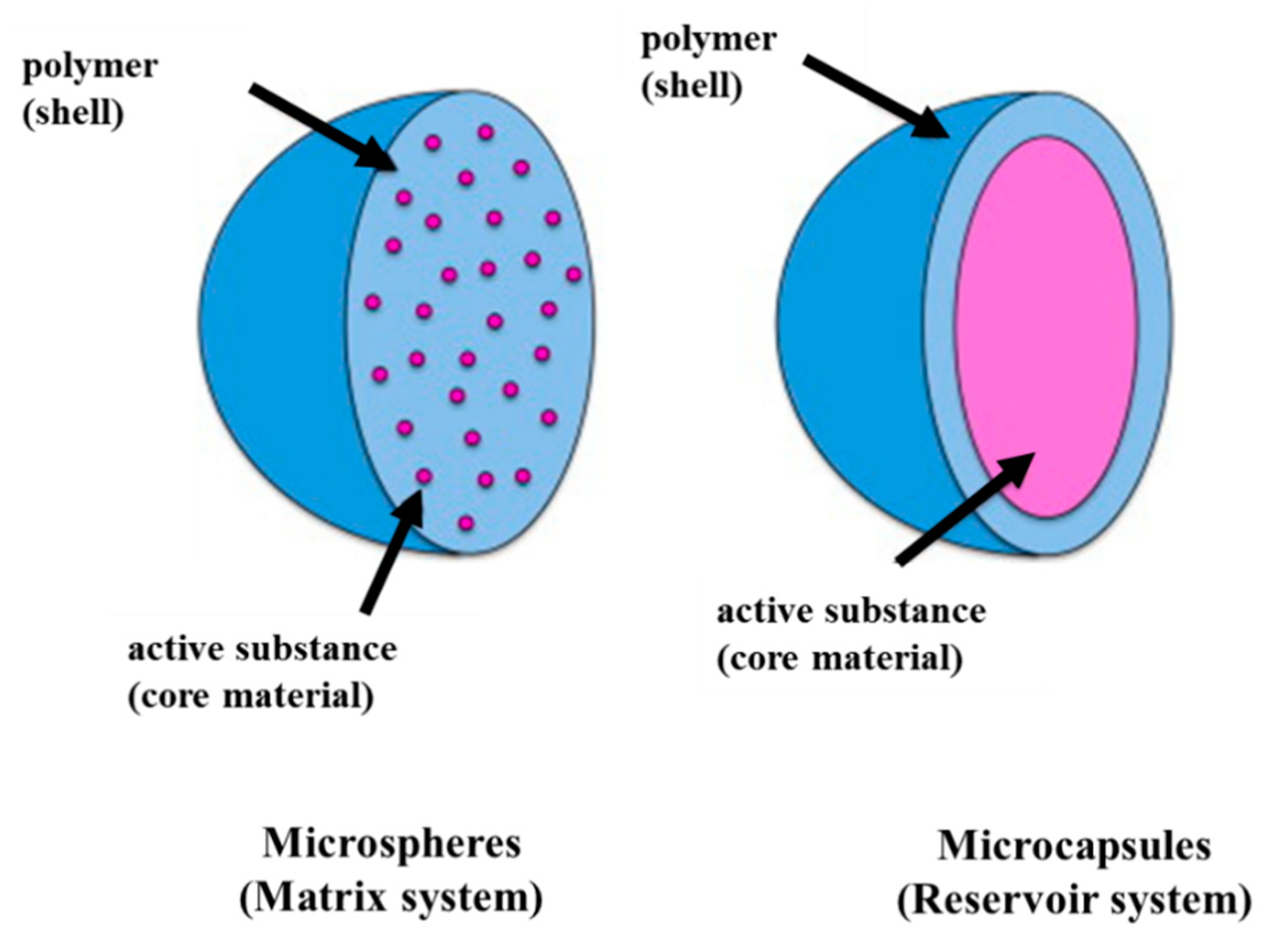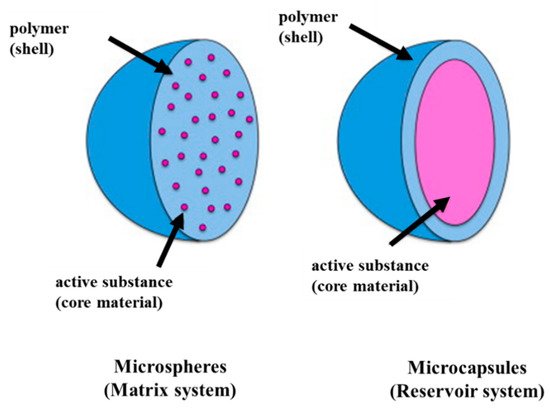Encapsulation is defined as the process in which an active substance (core material) is enveloped into another substance (shell/matrix/wall material) to elaborate particles with a specific geometry at the nanometer (nanoencapsulation), micrometer (microencapsulation) or millimeter scale. Some natural food antimicrobials with strong antimicrobial activity and low toxicity have been considered as alternatives for current commercial food preservatives. Nonetheless, these natural food antimicrobials are hardly applied directly to food products due to issues such as food flavor or bioavailability. Recent advances in microencapsulation technology have the potential to provide stable systems for these natural antibacterials, which can then be used directly in food matrices.
- microencapsulation
- natural antimicrobial agents
- encapsulation methods
- food applications
1. Introduction
1. Introduction


2. Encapsulation Methods
2. Encapsulation Methods
Microencapsulation Method | Wall Material | Antimicrobial Agent | Encapsulation Efficiency | Main Results | References | ||||||||||||
|---|---|---|---|---|---|---|---|---|---|---|---|---|---|---|---|---|---|
Inclusion | β-cyclodextrin | Eugenol | - | The eugenol-βCD complexes showed enhanced antibactieral activity compared to free eugenol (a concentration of eugenol higher than 5.03 mmol L−1 inhibited the growth of Staphylococcus aureus and Escherichia coli) |
[11] |
||||||||||||
Inclusion (KN-FD) | HPBCD |
3.2. Propolis
3.3. Antimicrobial Peptides
4. Food Applications of Encapsulated Antimicrobials
The microencapsulation of antimicrobial agents is used to prevent the growth of foodborne pathogens present in food systems without losing food quality and nutritional value. Microencapsulated antimicrobials alone or together with other processes were applied to improve the quality of various food products such as meats, dairy products and vegetables (4. Food Applications of Encapsulated Antimicrobials
Antimicrobial Agents | Wall Material | Encapsulation Method | Food Products | Target Microorganism | Main Results | References | |||||||||||||||||||
|---|---|---|---|---|---|---|---|---|---|---|---|---|---|---|---|---|---|---|---|---|---|---|---|---|---|
Nisin | Gum arabic | Spray drying | Milk |
L. monocytogenes, B. cereus |
Spray-dried commercial nisin had an antimicrobial effect under refrigeration (90 days) |
[66] |
[109] |
||||||||||||||||||
Clove oil | Β-CD–porous structure | Carvacrol | 78.09% for KN, and 83.74% for FD | Encapsulated carvacrol showed a lower minimum concentration (300 μg/mL) than free carvacrol (1000 μg/mL) for both bacteria, |
Spray drying | Meat products |
Escherichia coli and Salmonella enterica |
[12] |
|||||||||||||||||
Mold spores | Encapsulated clove oil had a strong heat resistance and a high antiseptic effect on meat products |
[67] |
[110] |
Inclusion (KN-FD) | |||||||||||||||||||||
Grape seed extract/carvacrol | β-cyclodextrin | Chitosan | Thymol and thyme oil | Ionic gelation | 71 to 83% | Salmon | β- cyclodextrine inclusion complexes were able to inhibit Escherichia coli at lower concentrations (0.37 mg/mL) than free oils. |
[ |
Psycrophilic, mesophilic bacteria, Pseudomonas spp. |
13] |
|||||||||||||||
Prepapred microcapsules increased the shelf-life of refrigerated salmon to 4–7 days of storage | [ | ] |
[111] |
Inclusion (by spray drying and precipitation methods) | |||||||||||||||||||||
Coconut shell liquid smoke | HPBCD, β-CD | Dextrin | Lemongrass volatile oil | Spray-drying | 56–60% and 26–29% using β-CD and HP-β-CD, respectively | Tilapia meat | More effective inclusion of lemongrass oil with beta-CD |
[ |
TPC14] | ||||||||||||||||
Formulated microcapsules could reduce quality deterioration on fresh fish meat | [ | 69] |
[112] |
Inclusion | Β-cyclodextrin, HE-β-CD, HP-β-CD | Eugenol | - | ||||||||||||||||||
Curcumin | Gelatin–porous starch | Spray-drying | Tofu/bread/cooked pork | The inclusion process was deduced to be an exothermic and enthalphy-driven process | Mold spores |
[15] |
|||||||||||||||||||
Compared with free curcumin, microcapsules reduced mold spores from (34.4 ± 2.5) to (52.3 ± 4.1)% | [ | ] |
[113] |
Spray drying | Low methoxyl pectin | ||||||||||||||||||||
Nisin | Lysozyme | Zein | Spray drying | - | milk | Higher pectin concentrations (above 0.5 g/L) preserved lysozyme structure and activity |
L. monocytogenes [16] |
||||||||||||||||||
Capsules were more effective than free antimicrobials in inhibiting the growth of | L. monocytogenes | in 2% reduced fat milk at 25 °C | [19] |
Spray drying | Gum arabic, starch, maltodextrin, inulin | Rosemary EO | - | ||||||||||||||||||
Rosemary EO | The combination of modified starch and inulin was shown to be a viable substitute for gum arabic in foods |
[ |
Modified starch–maltodextrin17] | ||||||||||||||||||||||
Spray drying | Fresh dough | Fungi and yeast | The encapsulated rosemary essential oil provided long-term antimicrobial activity when applied to fresh dough |
[71] |
[114] |
Spray drying | Modified starch, gum arabic, maltodextrin | ||||||||||||||||||
Nisin | Alginate–cellulose nanocrystals (CNC) microbeads | Oregano EO | - | Alginate microbead | RTE meat | The inlet air temperature and the emulsion feed rate significantly affected the powder recovery, moisture content and the oil retention |
[18] |
||||||||||||||||||
L. monocytogenes | Microencapsulation of nisin (63 μg/mL) increased the lag phase of bacterial growth up to 28 days |
[28] |
Spray drying | Zein | Nisin | - | Encapsulated nisin was more effective than free antimicrobials in inhibiting the growth of L. monocytogenes |
[19] |
|||||||||||||||||
Nisin Z | Proliposome H | Liposome | Cheddar cheese |
L. innocua Lactobacillus spp. L. casei subsp. casei |
Nisin-containing liposomes could provide a powerful tool to improve nisin stability and availability in the cheese matrix |
[72] |
[115] |
Simple coacervation | |||||||||||||||||
Lactoferrin | PVA crosslinked by glutaraldehyde | Corn oil–butter fat–polyglycerol polyricinoleate | Lemongrass EO | - | When SDS at 0.03 wt.% was used, no agglomeration was observed | Emulsification | Bologna slices |
[20] |
|||||||||||||||||
Carnobacterium viridans | Microencapsulated lactoferrin had greater antimicrobial activity against | Carnobacterium viridans than the free one |
Simple coacervation | Gelatin microparticles crosslinked with glutaraldehyde | Holy basil EO (HBEO) | 95.41% | Extended shelf-life of microencapsulated HBEO up to 18 months at 25 °C |
[21] |
|||||||||||||||||
Complex coacervation | Gelatin–gum arabic crosslinked with genipin | Mustard seed EO | - | Genipin-hardened microcapsules exhibited strong chemical stability with a particle size of mainly 5–10 μm |
[22] |
||||||||||||||||||||
Complex coacervation | Soy protein–pectin | Propolis extract | 72.01% and 66.12% for formulations with 2.5 and 5.0 g/100 mL of colloids, respectively | This process preserves the phenolic and flavonoids compounds with antioxidant activity and inhibitory activity of S. aureus |
[23] |
||||||||||||||||||||
Complex coacervation | Whey protein isolate–chitosan | Garlic extract | 51% to 61% | The CH/WPI complexes are revealed to be good alternatives for use as wall systems |
[24] |
||||||||||||||||||||
Single emulsion diffusion method | Poly lactic acid (PLA) | Nisin | 12 to 16% | The encapsulation efficiency was enhanced with the increase in nisin loading in the aqueous solution |
[25] |
||||||||||||||||||||
[ | ] | [116] |
Emulsion diffusion | Polycaprolacton (PCL) | Eugenol | 100%, 90.9% and 89.1% for PCL, β-CD eugenol and 2-HP-β-CD eugenol, respectively | The emulsion–diffusion method was more effective for eugenol encapsulation to protect against light oxidation during storage time |
[26] |
|||||||||||||||||
s/o/w emulsion–evaporation extraction | Poly (lactic-co-glycolic) (PLGA) | Lysozyme | 73% | More hydrophilic polymers were less prone to protein adsorption |
[27] |
||||||||||||||||||||
Alginate microbeads | Calcium alginate–cellulose nanocrystals (CNC) | Nisin | - | The beads containing nisin significantly reduced the L. monocytogenes counts after 28 days of storage compared with free nisin |
[28] |
||||||||||||||||||||
Alginate microbeads | Calcium–Alginate | Clove, thyme and cinnamon EOs | 90 to 94% | Encapsulation in Ca-alginate microspheres could effectively reduce the evaporation rate of EOs |
[29] |
||||||||||||||||||||
Alginate microbeads | Sodium alginate–guar gum | Nisin | 36.35% | The encapsulation efficiency of nisin under optimal conditions was 36.65% |
[30] |
||||||||||||||||||||
Ionic gelation | Sodium alginate | Propolis extract | 99.3% | Na-alginate encapsulation increased the bioavailability of propolis extract |
[31] |
||||||||||||||||||||
SAS | PLGA and CaCo3 | Lysozyme | ~60% | The supercritical CO2 process offers optimal conditions for protein stability and integrity and permitted the retention of 90% of the biological activity of lysozyme |
[32] |
||||||||||||||||||||
Liposome | PC, PC/PG | Nisin | 89–91, 78–83 and 72–78% for PC/PG 6:4, PC/PG 8:2 and PC, respectively | Liposomes formulated with PC and PG appeared to be relatively stable to pasteurization protocols |
[33] |
||||||||||||||||||||
Liposome and emulsification method | Lecithin–chol | Alginate, chitosan or starch | Plant herbs, spices and lyzozyme | - | Particles with co-encapsulated herbs and lysozyme are more active against different types of bacteria |
[34] |
|||||||||||||||||||
Vibrating technology | alginate | Nisin | 75% | Microcapsules efficiently protected nisin from protease activity and retarded nisin release |
[35] |
